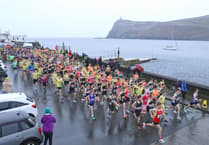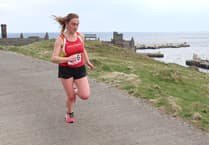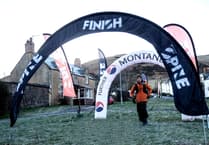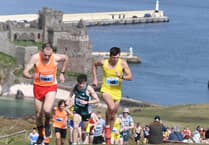A casual chat about local athletics in the early 1960s turned into so much more with Joe O’Hanlon. His involvement with running came at the age of 20 when he took part in a handicap race round Greeba sports field on Ballachurry Road in the spring of 1962.
He was encouraged to turn up by a few former schoolmates – including Guy Redmayne, Dougie Sandle and Malcolm Convery. Joe didn’t possess any running shoes at the time, so he simply removed his shoes and socks and rolled his trousers up to his knees and ran bare foot.
‘Arthur Currie was doing the handicapping for what was a 200-yard race so I was leading going into the home straight when Joe Cain thrust himself past me at the line,’ he explained.
It ignited a sporting interest into the young apprentice electrician working for Douglas Corporation, whose job involved carrying out running repairs on electric cookers and toasters that were then rented out to householders round the town.

Walking to and from work from his home in Pulrose kept him fit and he did well in country sports at venues like Andreas, Greeba, Cronk-y-Voddy and Laa Columb Killey. At one of them he won a magnificent box of fruit.
His true distance became the half-mile (or 800 metres as it is today), contesting bigger events at King George V Park Bowl and Onchan Park over distances such as a quarter-mile and 220 yards.
At one of them [possibly 1963] he learned a thing or two from a soon-to-be Olympic silver medallist Maurice Herriott, who at the time was dating Port St Mary girl Marina Coffey (later to be his wife).
‘Maurice changed me as a runner as when he passed me I watched his style and adapted mine accordingly.
‘Arthur [Currie] had set out the usual handicap, but Maurice chose to start a bit later to give him something to chase.

‘I had hit the front, then he went past me like a train, the ground shook by the energy/power that he was putting into each stride.
‘After that race, probably at Castle Rushen High School, I took something like four to six seconds from my half-mile times.
‘Up to then I ran with a soft foot, on a sort of energy conservation basis. I changed so that in full flight I hit the ground harder, so a 2:09 became 2:04 ish.’
‘I didn’t know it then, but the genetic condition I now have - idiopathic pulmonary fibrosis (IPF) - probably restricted me from running longer distances as I could never run a competitive mile as it quite possibly restricted the amount of oxygen I could get through my system.
He did contest longer events, such as the Peel to Douglas and even the TT 40 round the Mountain Course (plus Douglas Promenade).
‘The one day I had a serious go at the TT 40 I stopped at Ballaugh, much to the annoyance of my brother Brian who had said how well I was going. I knew and my body knew that I could not go any farther.’
He recalls defeating local footballer Tony Bottomley when they both went off from scratch in a race at Laa Columb Killey in Arbory. ‘It was one of those surreal moments when I seemed to float past him in the final 100 yards.’
Joe said that former newspaper production worker and long-time athletics correspondent Peter McElroy was a gentleman on the track. ‘At Onchan one time we both went off at scratch and me being a slow starter Peter got ahead, but he would then kindly lead me out over the final two-thirds of a lap and leave me to pick off the others as we got onto the finishing straight.’

His education began at the age of just three at the Sunshine School in Pulrose, known as such because of its big windows. He then went to Braddan at the age of five and secondary school at Ballakermeen up until the age of 16.
A member of Manx Athletics Club, he competed against a Royal Air Force team at Jurby in 1962.
What he regarded as the race of his time in running took place in the 1964 Manx AAA championships at the King George V Park Bowl, during the Manx Games.
‘The half-mile title was as good as mine going into it, but RAF man Peter Harrigay turned up and I knew things would be different.
‘I made a slow start at the back of the pack and remained steady until the last lap-and-a-third of the grass track which effectively had four bends each circuit.
‘I then took the race on and went from the back to the front. With about 200 yards left I did another kick and was going merrily along when Harrigay came along and stuck his shoulder into me going into the final bend. As it was the Manx Games, small flags marked the inside of the track and, wearing inch-long spikes, I knew that I daren’t go inside them as I’d risk disqualification.
‘I heard the public announcer [Stan Basnett] say: “It looks like O’Hanlon is beaten.”
‘That was fine for me, as I then made another surge forward, after which Stan said: “Oh no, he’s coming back”.
‘I gave it my all in the last few yards and honestly think I drew level and passed him shortly after the line, but although we were given the same time of 2min 03sec from memory, the split-decision was given to Peter.’
Joe briefly represented Salford RCAT (later University) when attending the college for a sandwich diploma course.
Whilst there he ran the Hyde Park Relay in February 1966, hosted by Imperial College London, when each of the six runners of the team ran three miles apiece. ‘I started too quickly and blew up,’ he admitted.
Driven by his professional ambition, Joe took a job in Canada working for the British Columbia Hydro and Power Authority in January 1967. ‘It was the experience of working with the big diesel engines at Pulrose Power Station that got me the job,’ he said.
Commissioning a new power plant in Vancouver, the job took him all over the country and as far north as Alaska. He described Vancouver as paradise, but he and his own wife-to-be Susan ultimately returned to the island in June 1972.
A Bachelor of Science, Joe was part of the ManxTT team that built a bike for the first all-electric TT [TTXGP] in 2009.
- He died on April 19, shortly after John Watterson interviewed him, after a long battle with his condition.
A service of thanksgiving will take place at St John’s Methodist Chapel this Saturday, May 11, at 2pm.





Comments
This article has no comments yet. Be the first to leave a comment.